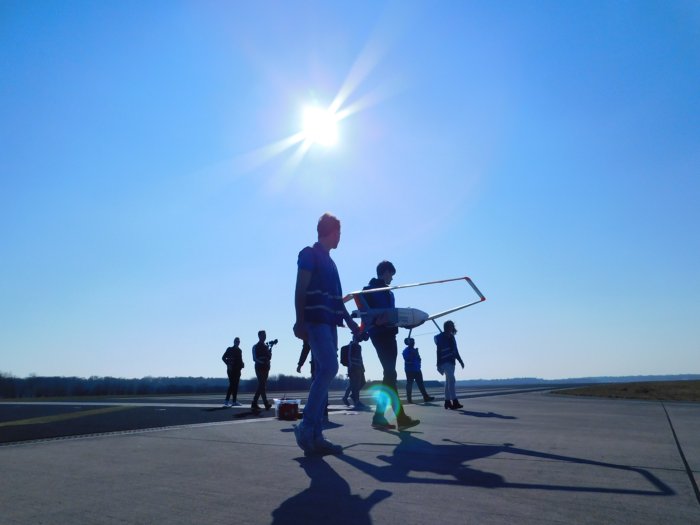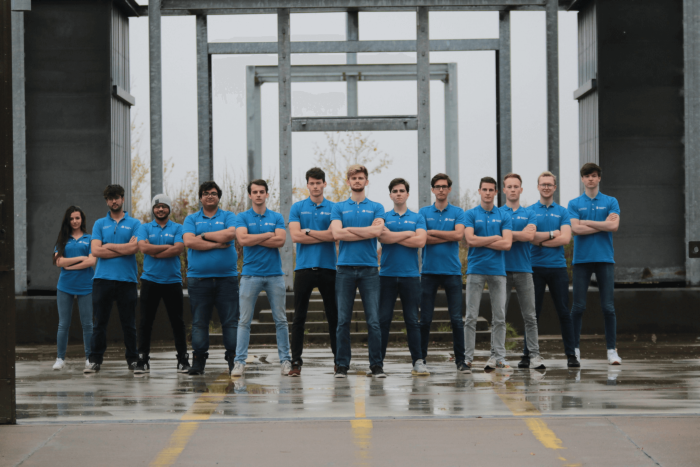The student team DroneTeam Twente unveiled their newest drone to the world: Thunderbird. The drone is designed for efficient medical aid delivery and uses an unique wing design that improves efficiency. With the aircraft, the team will compete against more than thirty other teams at the 2022 iMechE UAS Challenge, where the drone will carry out a simulated rescue mission.
The 2021-2022 team has been working since September to develop the new drone. Building upon previous years’ drone Phoenix, Thunderbird is more efficient while carrying a package with a higher range of more than 30 kilometres. Philippe Damoiseaux, Technical manager of the team explains how the team achieved that: “One of our goals is innovating the drone industry. That is why this year we have developed a cutting-edge drone, with an unique design: the wing goes all around the main body. This is called a ‘box-wing’, and it decreases aerodynamic drag, but it’s largely untested.”
Bas Kluijtmans, aerodynamicist, adds: “A crucial parameter for efficiency is the lift-to-drag ratio: the higher this value, the more efficient your wings, meaning you can carry your medical aid further and score more competition points. With the new design you can achieve more lift and reduced wingtip vortices, as the front and back wings are connected. You can also eliminate the horizontal stabiliser, decreasing drag further. The lowered drag also means speed goes up: the new drone can reach a theoretical top speed of more than 120 km/h.”
Lightweight drone
With a maximum competition weight of ten kilograms including payload, weight is a key issue for the team. In order to achieve the lowest mass possible, the team uses a completely 3D-printed outer fuselage with an internal carbon frame. Shervin Tochani, structural engineer of the team, explains how that works: “We use a special, foam-like plastic which we can make just strong enough to withstand the aerodynamic load. Then, these structural loads are transferred to the internal carbon frame with joints. This allows us to build a drone with a wingspan of two metres and keep it at the weight of about a bowling ball."

UAS Challenge
The competition the team is participating in this year is the iMechE UAS Challenge, taking place from 6-8 July 2022. This is a yearly competition with the goal of encouraging drone innovation, where 34 university teams compete with innovative drones and helicopters. In the event, the drone will need to carry out a simulated disaster rescue mission by navigating, locating and dropping a medical aid package to the right location while flying autonomously. The more efficient your drone does this, the more points you score. This year the team’s goal is to finish in the podium positions, and bring back home a prize to Enschede.
Time-sensitive deliveries
However, while winning the competition would be a huge achievement, DroneTeam Twente aims to go further than that: “We want our drone innovations to be applied in the real world for humanitarian purposes. That is why we are looking for applications together with NGOs in rural areas such as sub-saharan Africa”, Philippe explains. In these areas, medical aid is hard to access. The roads are unsuitable for cars, or villages are not in the right location on the map. This can lead to problems if, for example, an ambulance is needed. For this, cheaper and more efficient drones are crucial. Thunderbird has been developed as a low-cost alternative by using a 3D-printed body, which is easily and sustainably repaired. Examples where drones could help are time-sensitive deliveries, which includes vaccines, medicine and blood delivery. But drones can be used for more than that: “In the future, autonomous drones could be commonplace, and we are trying to make that happen.”

About DroneTeam Twente
DroneTeam Twente is a student team consisting of thirteen members with one common mission: innovating and accelerating the drone industry to make a positive impact. They do this by annually building an innovative drone and participating in the iMechE UAS Challenge, for which students need to design and develop new drone solutions that can perform an emergency aid mission. By participating in this, the team aims to achieve our larger ambition of making a difference with drones in developing countries. Together with the partners and the University of Twente they research and make these innovative drones possible, while also educating and inspiring people in Twente about drones and their applications.




